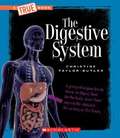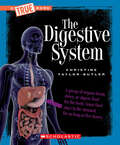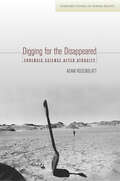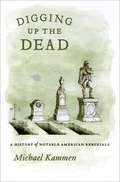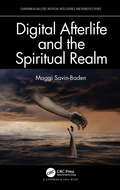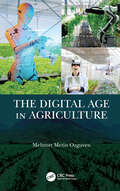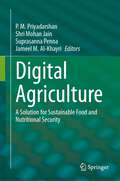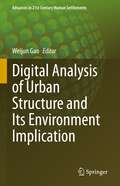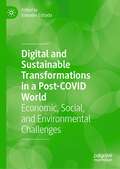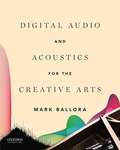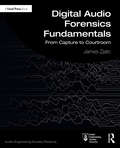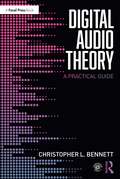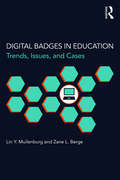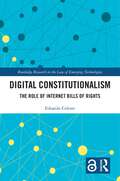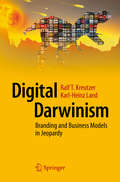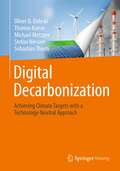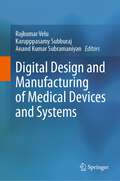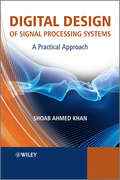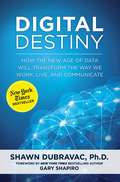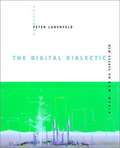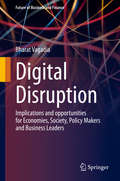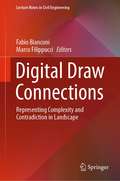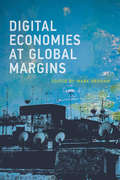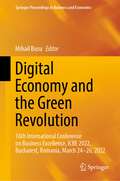- Table View
- List View
The Digestive System (A True Book: Health And The Human Body Ser.)
by Christine Taylor-ButlerAn introduction to the digestive system. This book introduces readers (Grades 3-5) to the digestive system, including the digestive process, the organs involved in digestion, and common problems and diseases associated with the digestive system.
The Digestive System (A True Book (Relaunch))
by Christine Taylor-ButlerAn introduction to the digestive system.This book introduces readers (Grades 3-5) to the digestive system, including the digestive process, the organs involved in digestion, and common problems and diseases associated with the digestive system.
Digging for the Disappeared: Forensic Science after Atrocity
by Adam RosenblattThe mass graves from our long human history of genocide, massacres, and violent conflict form an underground map of atrocity that stretches across the planet's surface. In the past few decades, due to rapidly developing technologies and a powerful global human rights movement, the scientific study of those graves has become a standard facet of post-conflict international assistance. Digging for the Disappeared provides readers with a window into this growing but little-understood form of human rights work, including the dangers and sometimes unexpected complications that arise as evidence is gathered and the dead are named. Adam Rosenblatt examines the ethical, political, and historical foundations of the rapidly growing field of forensic investigation, from the graves of the "disappeared" in Latin America to genocides in Rwanda and the former Yugoslavia to post-Saddam Hussein Iraq. In the process, he illustrates how forensic teams strive to balance the needs of war crimes tribunals, transitional governments, and the families of the missing in post-conflict nations. Digging for the Disappeared draws on interviews with key players in the field to present a new way to analyze and value the work forensic experts do at mass graves, shifting the discussion from an exclusive focus on the rights of the living to a rigorous analysis of the care of the dead. Rosenblatt tackles these heady, hard topics in order to extend human rights scholarship into the realm of the dead and the limited but powerful forms of repair available for victims of atrocity.
Digging Up the Dead: A History of Notable American Reburials
by Michael G. KammenA funeral closes a life story, and a grave in a cemetery marks its end forever. But what happens when those left behind don't agree about the meaning of that story? Or when that disagreement extends all the way to arguments about the final resting place itself? In a surprising number of cases over the years, that's when people have chosen to grab shovels and start digging. With Digging Up the Dead, Pulitzer Prize-winning historian Michael Kammen reveals a treasure trove of fascinating, surprising, and sometimes gruesome stories of exhumation and reburial from throughout American history. Taking us to the contested grave sites of such figures as Sitting Bull, John Paul Jones, Frank Lloyd Wright, Daniel Boone, Jefferson Davis, and even Abraham Lincoln, Kammen explores how complicated interactions of regional pride, shifting reputations, and evolving burial practices led to public, often emotional battles over the final resting places of famous figures. Grave-robbing, skull-fondling, cases of mistaken identity, and the financial lures of cemetery tourism all come into play as Kammen delves deeply into this little-known- yet surprisingly persistent- aspect of American history. Simultaneously insightful and interesting, masterly and macabre, Digging Up the Dead reminds us that the stories of American history don't always end when the key players pass on. Rather, the battle- over reputations, interpretations, and, last but far from least, possession of the remains themselves- is often just beginning.
Digital Afterlife and the Spiritual Realm (Chapman & Hall/CRC Artificial Intelligence and Robotics Series)
by Maggi Savin-BadenFew religious leaders have examined the potential for the positive impact of digital media and digital immortality creation in religious contexts. It is evident that there have been recent moves away from traditional funeral services focusing on the transition of the deceased into the future world beyond, towards a rise of memorial content within funerals and commemorative events. This has heralded shifts in afterlife beliefs by replacing them, to all intents and purposes, by attitudes to this life. Digital Afterlife and the Spiritual Realm explores the ways in which digital media and digital afterlife creation affects social and religious understandings of death and the afterlife. Features Understands the impact of digital media on those living and those working with the bereaved Explores the impact of digital memorialisation post death Examines the ways in which digital media may be changing conceptions and theologies of death For many people, digital afterlife and the spiritual realm largely remains an area that is both inchoate and confusing. This book will begin to unravel some of this bafflement.
The Digital Age in Agriculture
by Mehmet Metin OzguvenThe Digital Age in Agriculture presents information related to the digital age in the agriculture sector. Agriculture is an essential activity for the continuity of life, yet is very labor-intensive and faces a wide variety of challenges. In the struggle against these difficulties, the superior features offered by technology provide important benefits. These technologies require expertise in various technical disciplines, and The Digital Age in Agriculture provides information to readers allowing them to make more informed decisions and giving them the opportunity to improve agricultural productivity. Written by Mehmet Metin Özgüven, an expert who has conducted field studies and with a working technical knowledge of various topics pertaining to the agriculture age, this book covers many subjects important to the age of digital agriculture, including precision agriculture and livestock farming, using agricultural robots and unmanned arial vehicles in agriculture practices, and image processing and machine vision. It is an essential read for researchers, agriculture sector workers, and agricultural engineers.
Digital Agriculture: A Solution for Sustainable Food and Nutritional Security
by P. M. Priyadarshan Shri Mohan Jain Suprasanna Penna Jameel M. Al-KhayriThe world population is increasing while arable land is decreasing at an alarming rate. About one-quarter of arable land is degraded and needs significant restoration before it can sustain crops again. By 2030, the water supply will fall 40% short of meeting global demand. Moreover, looming climate change poses additional challenge to increasing food production to feed 10 billion people by 2050. Current major agricultural systems are on a largely unsustainable trajectory because of their contributions to greenhouse gas emissions, water pollution, and biodiversity loss.For these reasons, innovative technologies are being introduced in modern agriculture to sustain food production. They include digital and geospatial technologies to manage soil, climate and plant genetic resources. With the development of tools and sensors integrated into the internet of things (IoT) environment, physically collected information is converted into computer-readable language. Digital innovations thus allow real-time analysis, machine learning, and artificial intelligence (AI) that manage massive amount of data, also known as big data. Accordingly, digital agriculture affords greater potential for sustainable farming and economic benefits. This book summarizes the latest advances in AI-integration of agriculture practices. Specific focus includes but not limited to, big data, yield mapping, pests management, and optimal fertigation. As such, it presents a forward-looking approach to meet multiple UN Sustainable Development Goals, specifically, SDG 2, 6, 13 and 15.
Digital Analysis of Urban Structure and Its Environment Implication (Advances in 21st Century Human Settlements)
by Weijun GaoThis book provides new information to understand the relationship between urban development and environmental change to the reader. How to create a sustainable and livable urban environment and realize the sustainable development goals (SDGs) of the United Nations (UN) is one of the biggest challenges in this century, even in the next centuries. The covered subject areas of this book aim at finding a way to push SDGs forward by collecting the related knowledge between urban development and its environmental implication. Specifically, the book focuses on UN SDGs 9 (industry, innovation and infrastructure), 11 (sustainable cities and communities), and 13 (climate action). Regarding the SDGs 9, this book assesses urban population mobility, urban ecosystem services, and green infrastructure to address climate change in cities. Regarding the SDGs 11, this book explores the sustainability of urban landscape change associated with urbanization based on a multi-scale perspective. Regarding the SDGs 13, this book explores the issues affecting the development of healthy cities in the context of climate change and possible ways to address them. This book focuses on newer fields related to various forms of urbanization and urban climate. Under different urbanization and development scenarios, the city and built environment are facing new challenges and become a major concern. Better understandings of related physical laws and sustainable technologies are badly needed. This book is a good reference to urban planners, city officials, citizens who are concerned about the city environment, and policymakers, as well as students studying urban structure and environment.
The Digital and Its Discontents (Electronic Mediations #62)
by Aden Evens Alexander R. GallowayA groundbreaking critique of the digital world that analyzes its universal technological foundations Whence that nagging sense that something in the digital is amiss—that, as wonderful as our devices are, time spent on smartphones and computers leaves us sour, enervated, alienated? The Digital and Its Discontents uniquely explains that worry and points us toward a more satisfying relationship between our digital lives and our nondigital selves, one that requires a radical change in the way we incorporate technology into our lives. Aden Evens analyzes universal technological principles—in particular, the binary logic—to show that they encourage certain ways of thinking while making others more challenging or impossible. What is out of reach for any digital machine is contingency, the ontological principle that refuses every rule. As humans engage ourselves and our world ever more through digital machines, we are losing touch with contingency and so banishing from our lives the accidental and unexpected that fuel our most creative and novel possibilities for living. Taking cues from philosophy rather than cultural or media theory, Evens argues that the consequences of this erosion of contingency are significant yet often overlooked because the same values that make the digital seem so desirable also make contingency seem unimportant—without contingency the digital is confined to what has already been thought, and yet the digital&’s ubiquity has allowed it to disguise this inherent sterility. Responsive only to desires that meet the demands of its narrow logic, the digital requires its users to practice those same ideological dictates, instituting a hegemony of thought and value sustained by the pervasive presence of digital mechanisms. Interweaving technical and philosophical concepts, The Digital and Its Discontents advances a powerful and urgent argument about the digital and its impact on our lives. Retail e-book files for this title are screen-reader friendly.
Digital and Sustainable Transformations in a Post-COVID World: Economic, Social, and Environmental Challenges
by Salvador EstradaCurrent social, economic, and environmental challenges presented by the United Nations’ Sustainable Development Goals may be partially attained by digitalization and sustainable practices diffusion. The antecedents, occurrences, and consequences of this process are currently under investigation, but the big challenge is to get a systemic view. This book attempts to bring such a view into focus.Digital and Sustainable Transformations in a Post-COVID World is dedicated to studying the consequences of the global crisis caused by the COVID-19 pandemic and the new needs and practices inherent in developing and disseminating digital and clean technologies.
Digital Audio And Acoustics For The Creative Arts
by Mark BalloraDesigned for introductory courses in electronic music and multimedia, Digital Audio and Acoustics for the Creative Arts presents the fundamental concepts of musical acoustics, psychoacoustics, electronics, digital audio, audio recording, and communication among devices via the Musical Instrument Digital Interface (MIDI) and Open Sound Control (OSC).
Digital Audio Forensics Fundamentals: From Capture to Courtroom (Audio Engineering Society Presents)
by James ZjalicDigital Audio Forensics Fundamentals offers an accessible introduction to both the theory and practical skills behind this emerging field of forensic science. Beginning with an overview of the history of the discipline, the reader is guided through forensic principles and key audio concepts, before being introduced to practical areas such as audio enhancement, audio authentication, and the presentation of reports. Covering all aspects of audio forensics from the capture to the courtroom, this book is pivotal reading for beginners entering the field, as well as experienced professionals looking to develop their knowledge of the practice.
Digital Audio Theory: A Practical Guide
by Christopher L. BennettDigital Audio Theory: A Practical Guide bridges the fundamental concepts and equations of digital audio with their real-world implementation in an accessible introduction, with dozens of programming examples and projects. Starting with digital audio conversion, then segueing into filtering, and finally real-time spectral processing, Digital Audio Theory introduces the uninitiated reader to signal processing principles and techniques used in audio effects and virtual instruments that are found in digital audio workstations. Every chapter includes programming snippets for the reader to hear, explore, and experiment with digital audio concepts. Practical projects challenge the reader, providing hands-on experience in designing real-time audio effects, building FIR and IIR filters, applying noise reduction and feedback control, measuring impulse responses, software synthesis, and much more. Music technologists, recording engineers, and students of these fields will welcome Bennett’s approach, which targets readers with a background in music, sound, and recording. This guide is suitable for all levels of knowledge in mathematics, signals and systems, and linear circuits. Code for the programming examples and accompanying videos made by the author can be found on the companion website, DigitalAudioTheory.com.
Digital Badges in Education: Trends, Issues, and Cases
by Zane L. Berge Lin Y. MuilenburgIn recent years, digital badging systems have become a credible means through which learners can establish portfolios and articulate knowledge and skills for both academic and professional settings. Digital Badges in Education provides the first comprehensive overview of this emerging tool. A digital badge is an online-based visual representation that uses detailed metadata to signify learners’ specific achievements and credentials in a variety of subjects across K-12 classrooms, higher education, and workplace learning. Focusing on learning design, assessment, and concrete cases in various contexts, this book explores the necessary components of badging systems, their functions and value, and the possible problems they face. These twenty-five chapters illustrate a range of successful applications of digital badges to address a broad spectrum of learning challenges and to help readers formulate solutions during the development of their digital badges learning projects.
Digital Constitutionalism: The Role of Internet Bills of Rights (Routledge Research in the Law of Emerging Technologies)
by Edoardo CelesteInvestigating the impact of digital technology on contemporary constitutionalism, this book offers an overview of the transformations that are currently occurring at constitutional level, highlighting their link with ongoing societal changes. It reconstructs the multiple ways in which constitutional law is reacting to these challenges and explores the role of one original response to this phenomenon: the emergence of Internet bills of rights. Over the past few years, a significant number of Internet bills of rights have emerged around the world. These documents represent non-legally binding declarations promoted mostly by individuals and civil society groups that articulate rights and principles for the digital society. This book argues that these initiatives reflect a change in the constitutional ecosystem. The transformations prompted by the digital revolution in our society ferment under a vault of constitutional norms shaped for ‘analogue’ communities. Constitutional law struggles to address all the challenges of the digital environment. In this context, Internet bills of rights, by emerging outside traditional institutional processes, represent a unique response to suggest new constitutional solutions for the digital age. Explaining how constitutional law is reacting to the advent of the digital revolution and analysing the constitutional function of Internet Bills of Rights in this context, this book offers a global comparative investigation of the latest transformations that digital technology is generating in the constitutional ecosystem and highlights the plural and multilevel process that is contributing to shape constitutional norms for the Internet age.
Digital Darwinism
by Ralf T. Kreutzer Karl-Heinz LandDigital Darwinism is a key challenge for all companies and brands. Not all companies and managers are aware of the challenges lying ahead. This book helps to identify the need for change and adaption based on a framework of findings and additional tools to position you and your company in the digital rat race.
Digital Decarbonization: Achieving climate targets with a technology-neutral approach
by Thomas Kaiser Oliver D. Doleski Michael Metzger Stefan Niessen Sebastian ThiemDecarbonization through optimized energy flows. In this book you will learn how a significant reduction in climate changing greenhouse gas emissions can be achieved through systemic optimization of our energy systems. The authors clearly demonstrate how energy-intensive processes can be optimized flexibly by using technology-neutral simulation methods to ensure that significantly fewer greenhouse gases are emitted.Such field-tested, data-based energy models described in this publication prove that "digital decarbonization" enables an economy that releases significantly fewer climate changing emissions while maintaining its production output. This is a promising message in view of ongoing climate change.
Digital Design and Manufacturing of Medical Devices and Systems
by Rajkumar Velu Karupppasamy Subburaj Anand Kumar SubramaniyanThis book coherently presents the advances in technological principles, processes, and methods of Additive Manufacturing (AM), Augmented reality (AR), and Internet of things (IoT) in biomedical technology. It offers an overview of these high-impact technologies in terms of materials, processes, and in-situ monitoring of fabricating biomedical devices, implants, and prosthetics. Furthermore, the book also aimed to cover pedagogical applications, including the design and development of high-fidelity anatomical and hybrid physiological human models, for medical and design students and clinicians for learning, understanding, and gaining insights into the structures and functions of human organs and pathology. In turn, the book also discusses the applications of artificial intelligence in the 3-D printing of pharmaceuticals. This book is a useful resource for manufacturers, scientists, engineers, and young research scholars understand disruptive technology's real potential in biomedicalapplications.
Digital Design of Signal Processing Systems: A Practical Approach
by Shoab Ahmed KhanDigital Design of Signal Processing Systems discusses a spectrum of architectures and methods for effective implementation of algorithms in hardware (HW). Encompassing all facets of the subject this book includes conversion of algorithms from floating-point to fixed-point format, parallel architectures for basic computational blocks, Verilog Hardware Description Language (HDL), SystemVerilog and coding guidelines for synthesis. The book also covers system level design of Multi Processor System on Chip (MPSoC); a consideration of different design methodologies including Network on Chip (NoC) and Kahn Process Network (KPN) based connectivity among processing elements. A special emphasis is placed on implementing streaming applications like a digital communication system in HW. Several novel architectures for implementing commonly used algorithms in signal processing are also revealed. With a comprehensive coverage of topics the book provides an appropriate mix of examples to illustrate the design methodology. Key Features: A practical guide to designing efficient digital systems, covering the complete spectrum of digital design from a digital signal processing perspective Provides a full account of HW building blocks and their architectures, while also elaborating effective use of embedded computational resources such as multipliers, adders and memories in FPGAs Covers a system level architecture using NoC and KPN for streaming applications, giving examples of structuring MATLAB code and its easy mapping in HW for these applications Explains state machine based and Micro-Program architectures with comprehensive case studies for mapping complex applications The techniques and examples discussed in this book are used in the award winning products from the Center for Advanced Research in Engineering (CARE). Software Defined Radio, 10 Gigabit VoIP monitoring system and Digital Surveillance equipment has respectively won APICTA (Asia Pacific Information and Communication Alliance) awards in 2010 for their unique and effective designs.
Digital Destiny: How the New Age of Data Will Transform the Way We Work, Live, and Communicate
by Gary Shapiro Shawn DubravacOur world is about to change.<P> In Digital Destiny: How the New Age of Data Will Change the Way We Live, Work, and Communicate, Shawn DuBravac, chief economist and senior director of research at the Consumer Electronics Association (CEA), argues that the groundswell of digital ownership unfolding in our lives signals the beginning of a new era for humanity. Beyond just hardware acquisition, the next decade will be defined by an all-digital lifestyle and the “Internet of Everything”—where everything, from the dishwasher to the wristwatch, is not only online, but acquiring, analyzing, and utilizing the data that surrounds us. But what does this mean in practice?<P> It means that some of mankind’s most pressing problems, such as hunger, disease, and security, will finally have a solution. It means that the rise of driverless cars could save thousands of American lives each year, and perhaps hundreds of thousands more around the planet. It means a departure from millennia-old practices, such as the need for urban centers. It means that massive inefficiencies, such as the supply chains in Africa allowing food to rot before it can be fed to the hungry, can be overcome. It means that individuals will have more freedom in action, work, health, and pursuits than ever before.
The Digital Dialectic: New Essays On New Media
by Peter LunenfeldComputers linked to networks have created the first broadly used systems that allow individuals to create, distribute, and receive audiovisual content with the same box. They challenge theorists of digital culture to develop interaction-based models to replace the more primitive models that allow only passive use. The Digital Dialectic is an interdisciplinary jam session about our visual and intellectual cultures as the computer recodes technologies, media, and art forms. Unlike purely academic texts on new media, the book includes contributions by scholars, artists, and entrepreneurs, who combine theoretical investigations with hands-on analysis of the possibilities (and limitations) of new technology. The key concept is the digital dialectic: a method to ground the insights of theory in the constraints of practice. The essays move beyond journalistic reportage and hype into serious but accessible discussion of new technologies, new media, and new cultural forms.
Digital Disruption: Implications and opportunities for Economies, Society, Policy Makers and Business Leaders (Future of Business and Finance)
by Bharat VagadiaThis book goes beyond the hype, delving into real world technologies and applications that are driving our future and examines the possible impact these changes will have on industries, economies and society at large. It details the actions governments and regulators must take in order to ensure these changes bring about positive benefits to the public without stifling innovation that may well be the future source of value creation. It examines how organisations in a world of digital ecosystems, where industry boundaries are blurring, must undertake radical digital transformation to survive and thrive in this new digital world. The reader is taken through a framework that critically examines (i) Digital Connectivity including 5G and IoT; (ii) Data Capture and Distribution which includes smart connected verticals; (iii) Data Integrity, Control and Tokenisation that includes cyber security, digital signatures, blockchain, smart contracts, digital assets and cryptocurrencies; (iv) Data Processing and Artificial Intelligence; and (v) Disruptive Applications which include platforms, virtual and augmented reality, drones, autonomous vehicles, digital twins and digital assistants.
Digital Draw Connections: Representing Complexity and Contradiction in Landscape (Lecture Notes in Civil Engineering #107)
by Fabio Bianconi Marco FilippucciThis book stems from the seminal work of Robert Venturi and aims at re-projecting it in the current cultural debate by extending it to the scale of landscape and placing it in connection with representative issues. It brings out the transdisciplinary synthesis of a necessarily interdisciplinary approach to the theme, aimed at creating new models which are able to represent the complexity of a contradictory reality and to redefine the centrality of human dimension. As such, the volume gathers multiple experiences developed in different geographical areas, which come into connection with the role of representation. Composed of 43 chapters written by 81 authors from around the world, with an introduction by Jim Venturi and Cezar Nicolescu, the volume is divided into two parts, the first one more theoretical and the other one which showcases real-world applications, although there is never a total split between criticism and operational experimentation of research.
Digital Economies at Global Margins (International Development Research Centre)
by Mark GrahamInvestigations of what increasing digital connectivity and the digitalization of the economy mean for people and places at the world's economic margins.Within the last decade, more than one billion people became new Internet users. Once, digital connectivity was confined to economically prosperous parts of the world; now Internet users make up a majority of the world's population. In this book, contributors from a range of disciplines and locations investigate the impact of increased digital connectivity on people and places at the world's economic margins. Does the advent of a digitalized economy mean that those in economic peripheries can transcend spatial, organizational, social, and political constraints—or do digital tools and techniques tend to reinforce existing inequalities?The contributors present a diverse set of case studies, reporting on digitalization in countries ranging from Chile to Kenya to the Philippines, and develop a broad range of theoretical positions. They consider, among other things, data-driven disintermediation, women's economic empowerment and gendered power relations, digital humanitarianism and philanthropic capitalism, the spread of innovation hubs, and two cases of the reversal of core and periphery in digital innovation.ContributorsNiels Beerepoot, Ryan Burns, Jenna Burrell, Julie Yujie Chen, Peter Dannenberg, Uwe Deichmann, Jonathan Donner, Christopher Foster, Mark Graham, Nicolas Friederici, Hernan Galperin, Catrihel Greppi, Anita Gurumurthy, Isis Hjorth, Lilly Irani, Molly Jackman, Calestous Juma, Dorothea Kleine, Madlen Krone, Vili Lehdonvirta, Chris Locke, Silvia Masiero, Hannah McCarrick,Deepak K. Mishra, Bitange Ndemo, Jorien Oprins, Elisa Oreglia, Stefan Ouma, Robert Pepper, Jack Linchuan Qiu, Julian Stenmanns, Tim Unwin, Julia Verne, Timothy Waema
Digital Economy and the Green Revolution: 16th International Conference on Business Excellence, ICBE 2022, Bucharest, Romania, March 24-26, 2022 (Springer Proceedings in Business and Economics)
by Mihail BusuThis book presents a selection of the best papers from the 16th International Conference on Business Excellence, “New Challenges of the Century. Digital Economy and the Green Revolution” (ICBE 2022), held in Bucharest, Romania, in March 2022. Showcasing research findings and perspectives on the new challenges posed by the digital economy and research systems, the book offers valuable insights into the present context of global crisis, together with solutions for the real-world challenges we face today.
